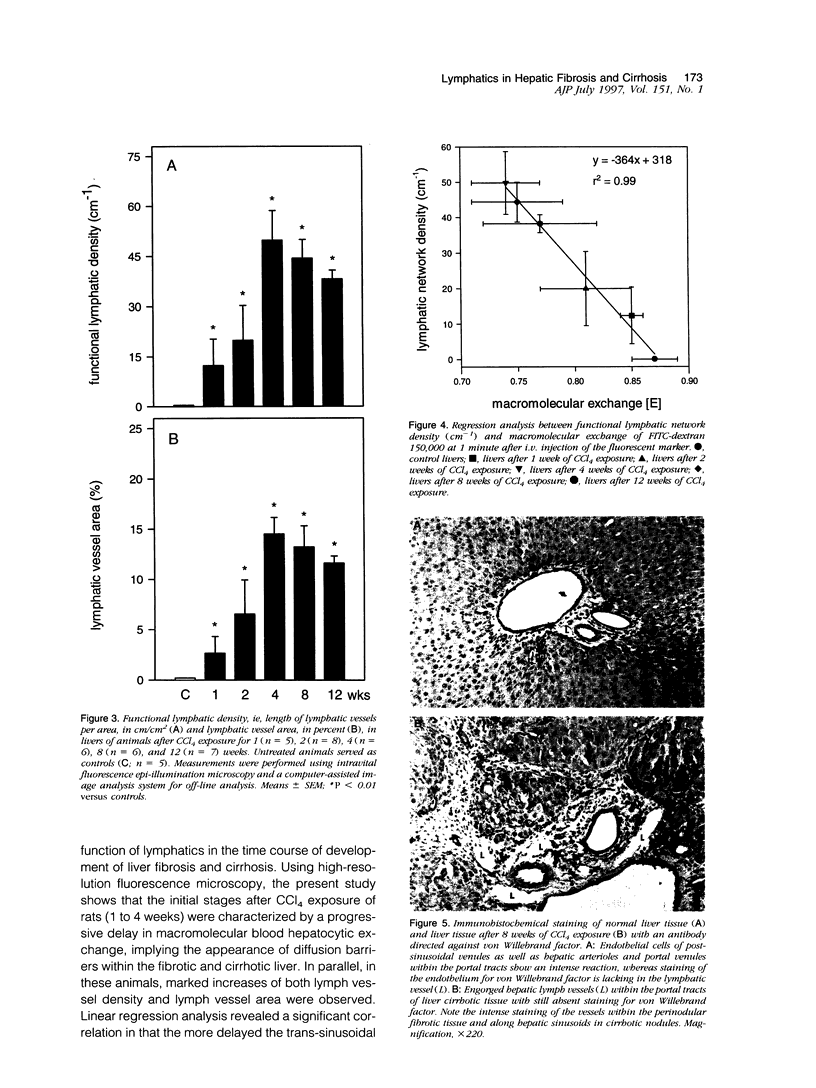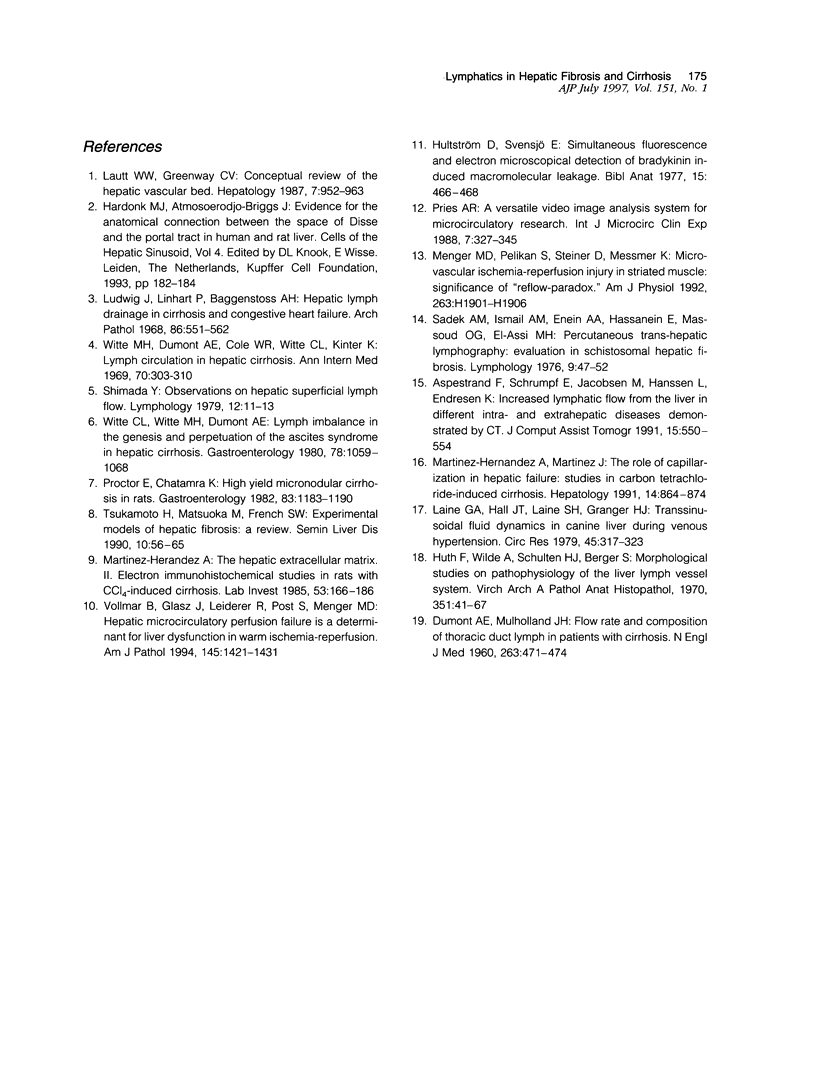Abstract
The process of lymph vessel expansion and function in the development of CCl4-induced hepatic fibrosis and cirrhosis was studied using intravital fluorescence microscopy of the rat liver. The unique aspect of our approach was the use of high molecular fluorescein-isothiocyanate-labeled dextran (MW, 150,000) as fluorescent marker, which allowed for simultaneous assessment of both 1) the macromolecular blood hepatocytic exchange from the sinusoidal microvasculature (extra-/intrasinusoidal gray level intensity at 1, 3, 5, and 10 minutes after intravenous injection) and 2) the hepatic lymph system. In animals exposed with CCl4 up to 4 weeks, macromolecular trans-sinusoidal exchange was found progressively delayed. This was strongly associated with lymph vessel expansion and function, as indicated by a continuous increase of lymph vessel density and area. Delay of macromolecular exchange and lymph vessel expansion was found not further enhanced at fibrotic and cirrhotic stages of 8- and 12-week CCl4-exposed livers. Linear regression analysis revealed a strong negative correlation between lymphatic network density development and macromolecular trans-sinusoidal exchange (r2 = 0.99; P < 0.01). Thus, our study provides for the first time direct evidence for the pivotal role of lymphatic function for macromolecular transport in case of deteriorated sinusoidal hepatocellular exchange capacity.
Full text
PDF






Images in this article
Selected References
These references are in PubMed. This may not be the complete list of references from this article.
- Aspestrand F., Schrumpf E., Jacobsen M., Hanssen L., Endresen K. Increased lymphatic flow from the liver in different intra- and extrahepatic diseases demonstrated by CT. J Comput Assist Tomogr. 1991 Jul-Aug;15(4):550–554. doi: 10.1097/00004728-199107000-00004. [DOI] [PubMed] [Google Scholar]
- DUMONT A. E., MULHOLLAND J. H. Flow rate and composition of thoracic-duct lymph in patients with cirrhosis. N Engl J Med. 1960 Sep 8;263:471–474. doi: 10.1056/NEJM196009082631001. [DOI] [PubMed] [Google Scholar]
- Hultström D., Svensjö E. Simultaneous fluorescence and electron microscopical detection of bradykinin induced macromolecular leakage. Bibl Anat. 1977;(15 Pt 1):466–468. [PubMed] [Google Scholar]
- Laine G. A., Hall J. T., Laine S. H., Granger J. Transsinusoidal fluid dynamics in canine liver during venous hypertension. Circ Res. 1979 Sep;45(3):317–323. doi: 10.1161/01.res.45.3.317. [DOI] [PubMed] [Google Scholar]
- Lautt W. W., Greenway C. V. Conceptual review of the hepatic vascular bed. Hepatology. 1987 Sep-Oct;7(5):952–963. doi: 10.1002/hep.1840070527. [DOI] [PubMed] [Google Scholar]
- Ludwig J., Linhart P., Baggenstoss A. H. Hepatic lymph drainage in cirrhosis and congestive heart failure. A postmortem lymphangiographic study. Arch Pathol. 1968 Nov;86(5):551–562. [PubMed] [Google Scholar]
- Martinez-Hernandez A., Martinez J. The role of capillarization in hepatic failure: studies in carbon tetrachloride-induced cirrhosis. Hepatology. 1991 Nov;14(5):864–874. doi: 10.1002/hep.1840140519. [DOI] [PubMed] [Google Scholar]
- Martinez-Hernandez A. The hepatic extracellular matrix. II. Electron immunohistochemical studies in rats with CCl4-induced cirrhosis. Lab Invest. 1985 Aug;53(2):166–186. [PubMed] [Google Scholar]
- Pries A. R. A versatile video image analysis system for microcirculatory research. Int J Microcirc Clin Exp. 1988 Nov;7(4):327–345. [PubMed] [Google Scholar]
- Proctor E., Chatamra K. High yield micronodular cirrhosis in the rat. Gastroenterology. 1982 Dec;83(6):1183–1190. [PubMed] [Google Scholar]
- Sadek A. M., Ismail A. M., Aboul Enein A., Hassanein E., Massoud O. G., El-Assi M. H. Percutaneous trans hepatic lymphography: evaluation in schistosomal hepatic fibrosis. Lymphology. 1976 Jun;9(2):47–52. [PubMed] [Google Scholar]
- Shimada Y. Observations on hepatic superficial lymph flow. Lymphology. 1979 Mar;12(1):11–13. [PubMed] [Google Scholar]
- Tsukamoto H., Matsuoka M., French S. W. Experimental models of hepatic fibrosis: a review. Semin Liver Dis. 1990 Feb;10(1):56–65. doi: 10.1055/s-2008-1040457. [DOI] [PubMed] [Google Scholar]
- Vollmar B., Glasz J., Leiderer R., Post S., Menger M. D. Hepatic microcirculatory perfusion failure is a determinant of liver dysfunction in warm ischemia-reperfusion. Am J Pathol. 1994 Dec;145(6):1421–1431. [PMC free article] [PubMed] [Google Scholar]
- Witte C. L., Witte M. H., Dumont A. E. Lymph imbalance in the genesis and perpetuation of the ascites syndrome in hepatic cirrhosis. Gastroenterology. 1980 May;78(5 Pt 1):1059–1068. [PubMed] [Google Scholar]
- Witte M. H., Dumont A. E., Cole W. R., Witte C. L., Kintner K. Lymph circulation in hepatic cirrhosis: effect of portacaval shunt. Ann Intern Med. 1969 Feb;70(2):303–310. doi: 10.7326/0003-4819-70-2-303. [DOI] [PubMed] [Google Scholar]





